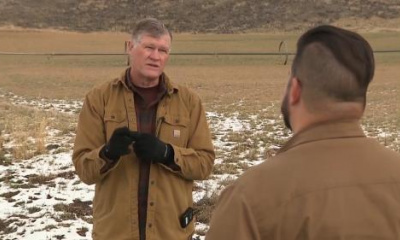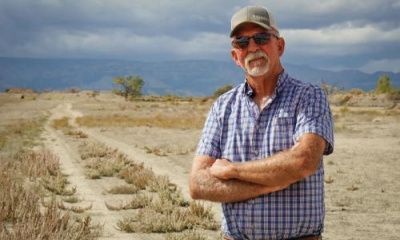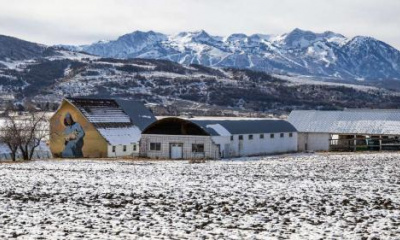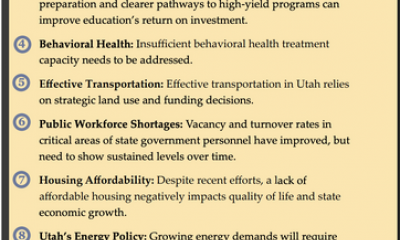First Great Salt Lake Summit strives for solutions
Brad Wilson, a bunch of other folks and a dog named Max took to the waters of the Great Salt Lake on airboats one recent December morning.
Wilson, the Republican Utah House speaker whose district in Davis County includes a large chunk of the lake, said it was only days later when the chill in his bones finally left.
But he said he would not have had it any other way.
“The breathtakingly beautiful lake at that time of year is something I had never experienced,” he said. “The sounds and the sights of the birds as they flew across the lake ... and we were there long enough that I was able to watch the sunrise over the marshes and the sunset over the lake and over the islands. It really was an unforgettable day.”
Wilson, who convened the first summit on the Great Salt Lake at the Davis Conference Center in Layton on Wednesday, said a trip like that should be on everyone’s bucket list.
“The Great Salt Lake is quiet and beautiful, yet a really harsh place and it’s an otherworldly place, especially that time of year.”
The ailing Great Salt Lake
But the lake is in trouble, which is why hundreds of people representing myriad agencies, advocacy organizations, industry and sportsmen convened for the half-day summit, making plain that fixing what ails the lake is a top political, fiscal and conservation goal for all.
The lake, drained by diversions and drought, dropped below its lowest recorded level logged in 1963 this last summer and continues to remain below that historic low.
Continuing diminishment of the saline lake holds all sorts of ugly ramifications not only for Utah — which puts the value of the lake at $1.5 billion in today’s dollars — but for global recipients of its natural resources.
The lake, for example, produces 40% of the world’s brine shrimp harvest and provides the minerals to constitute North America’s only supply of primary magnesium, which is used in all sorts of products including as an alloy with aluminum, in luggage, laptops, cameras and power tools.
Then there’s the birds.
The lake is along the Pacific Flyway for millions of migratory waterfowl, supporting at least 35 species that use its wetlands as a key stopover on their journey.
Those birds are part of an intricate and somewhat delicate ecosystem — despite its rugged looks — that draws millions of enthusiastic birdwatchers each year.
Two University of Utah researchers, one specializing in lake-borne dust and the other who studies lake-effect snow and how dust accelerates snowmelt, said a lake in crisis is one that puts people’s health and industry in crisis.
It also puts billions on the table to spend in mitigation efforts to ward off a scenario like that of California’s Lake Owens or Iran’s Lake Urmia — two saline lakes that essentially died.
The Aral Sea, once the world’s fourth largest inland body of water, now occupies just 5% of its former surface area.
For the last five years, the U.’s Kevin Perry has intensely focused his research on the emission of dust from the exposed bed of the Great Salt Lake. He’s personally trekked the entire 800 square miles of the exposed area.
He said if people think the devastation of a dry Owens Lake or Lake Urmia can’t happen here — “think again.”
California has spent $2 billion to mitigate the effects of Owens Lake, which is the largest source of dust pollution in North America, and it has still not solved the problem.
Studies on the content of dust exposed by the dwindling Great Salt Lake show concentrations of harmful heavy metals, including arsenic.
Perry showed a video of wind-whipped dust infiltrating Salt Lake City and the lungs of residents.
“This is real, this is tangible, you can see it and (it) doesn’t just stop in Salt Lake City,” he said.
That dust, with acute exposure can lead to certain types of cancer and cardiovascular disease.
It also threatens the ski industry by accelerating snowmelt as well as the state’s chief source of water — mountain snowpack.
S. McKenzie Skyles has been studying the effects of dust on snow and pointed to one event in 2017 at an Alta measuring station in which dust accelerated the snowmelt by a week.
She added that while not all dust on snow observed in Utah’s mountains comes from the exposed lake bed, the problem is its proximity to the snowpack.
“It is so close to the snow. The distance is measured in tens of miles, not hundred of miles,” Skyles said.
Low water levels are pictured in the Great Salt Lake near Tooele County on Wednesday, Jan. 5, 2022.
Money and more money
The state’s budget recommendations include a proposed $50 million for the Great Salt Lake and money for secondary water metering as part of a statewide push to adopt the technology and more money to make agricultural use of water more efficient.
Tage Flint, general manager of the Weber Basin Water District, said the best water is conserved water but it is not the only answer to the lake’s woes.
Water efficiency measures have helped to delay some water development projects, but he warned that with population growth that may not be the cure-all.
“The Great Salt Lake will drive water policy for northern Utah and it should,” Flint said.
While $50 million is the first initial stab at addressing the problems of the Great Salt Lake, many agree more will be needed — perhaps billions — if the fix is to be longterm.
Rep. Timothy Hawkes, R-Centerville, said the state can no longer afford to sit by and lack an aggressive solution.
“Doing nothing,” he said, “puts the lake on critical life support.”









